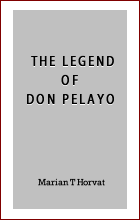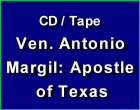Stories & Legends
 |
 |
 |
 |
 |
 |
 |
Blessed Alan de la Roche &
the Revival of the Rosary
All things, even the holiest, are subject to change, especially when they are dependent on man’s free will. It is hardly to be wondered at, then, that the Confraternity of the Holy Rosary only retained its first fervor for a century after it was instituted by St. Dominic. After this it was like a thing buried and forgotten.
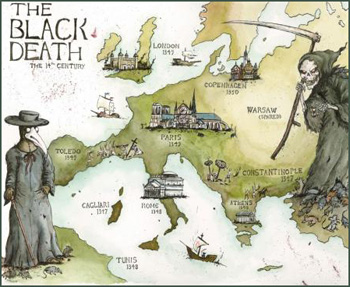 Doubtless, too, the wicked scheming and jealousy of the Devil were largely responsible for getting people to neglect the Rosary, and thus block the flow of God’s grace that it had drawn upon the world.
Doubtless, too, the wicked scheming and jealousy of the Devil were largely responsible for getting people to neglect the Rosary, and thus block the flow of God’s grace that it had drawn upon the world.
Thus, in 1349 God punished the whole of Europe with the most terrible plague that had ever been known. Starting in the East, it spread throughout Italy, Germany, France, Poland and Hungary, bringing desolation wherever it went, for out of a hundred men hardly one lived to tell the tale. Big cities, towns, villages and monasteries were almost completely deserted during the three years that the epidemic lasted.
This scourge of God was quickly followed by two others, the heresy of the Flagellants (1) and a tragic Schism in 1376. (2)
Alan ordered to revive the Rosary
Later on, when these trials were over, thanks to the mercy of God, Our Lady told Blessed Alan to revive the former Confraternity of the Holy Rosary. Blessed Alan was one of the Dominican Fathers at the monastery at Dinan in Brittany [France]. He was an eminent theologian and a famous preacher. Our Lady chose him because, since the Confraternity had originally been started in that province, it was fitting that a Dominican from the same province should have the honor of re-establishing it. (3)
Blessed Alan began this great work in 1460, after a special warning from Our Lord. This is how he received that urgent message, as he himself tells it:
One day when he was offering Mass, Our Lord, Who wished to spur him on to preach the Holy Rosary, spoke to him in the Sacred Host. “How can you crucify me again so soon?”
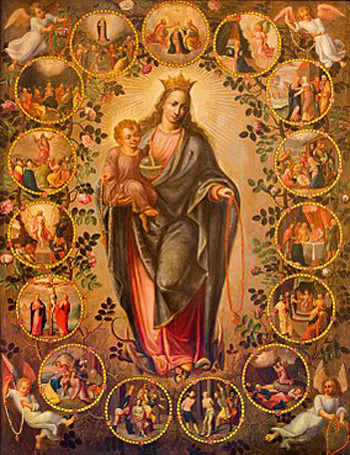 “What did you say, Lord?” asked Blessed Alan, horrified.
“What did you say, Lord?” asked Blessed Alan, horrified.
“You crucified Me once before by your sins,” answered Jesus, “and I would willingly be crucified again rather than have My Father offended by the sins you used to commit. You are crucifying Me again now because you have all the learning and understanding that you need to preach My Mother’s Rosary, and you are not doing it. If you only did that, you could teach many souls the right path and lead them away from sin. But you are not doing it, and so you yourself are guilty of the sins that they commit.”
This terrible reproach made Blessed Alan solemnly resolve to preach the Rosary unceasingly. (4)
Our Lady also said to him one day to inspire him to preach the Rosary more and more: “You were a great sinner in your youth, but I obtained the grace of your conversion from my Son. Had such a thing been possible, I would have liked to have gone through all kinds of suffering to save you, because converted sinners are a glory to me. (5) And I would have done that also to make you worthy of preaching my Rosary far and wide.”
St. Dominic appeared to Blessed Alan as well (6) and told him of the great results of his ministry: he had preached the Rosary unceasingly, his sermons had born great fruit and many people had been converted during his missions.
He said to Blessed Alan: “See what wonderful results I have had through preaching the Rosary. You and all who love Our Lady ought to do the same so that, by means of this holy practice of the Rosary, you may draw all people to the real science of the virtues.” (7)
Briefly, then, this is the history of how St. Dominic established the Holy Rosary and of how Blessed Alan de la Roche restored it.

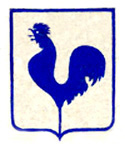

The Black Death depopulated Catholic Europe, hitting these cities especially hard
Thus, in 1349 God punished the whole of Europe with the most terrible plague that had ever been known. Starting in the East, it spread throughout Italy, Germany, France, Poland and Hungary, bringing desolation wherever it went, for out of a hundred men hardly one lived to tell the tale. Big cities, towns, villages and monasteries were almost completely deserted during the three years that the epidemic lasted.
This scourge of God was quickly followed by two others, the heresy of the Flagellants (1) and a tragic Schism in 1376. (2)
Alan ordered to revive the Rosary
Later on, when these trials were over, thanks to the mercy of God, Our Lady told Blessed Alan to revive the former Confraternity of the Holy Rosary. Blessed Alan was one of the Dominican Fathers at the monastery at Dinan in Brittany [France]. He was an eminent theologian and a famous preacher. Our Lady chose him because, since the Confraternity had originally been started in that province, it was fitting that a Dominican from the same province should have the honor of re-establishing it. (3)
Blessed Alan began this great work in 1460, after a special warning from Our Lord. This is how he received that urgent message, as he himself tells it:
One day when he was offering Mass, Our Lord, Who wished to spur him on to preach the Holy Rosary, spoke to him in the Sacred Host. “How can you crucify me again so soon?”

Our Lady orders Blessed Alan de Roche to revive the devotion of the Rosary
“You crucified Me once before by your sins,” answered Jesus, “and I would willingly be crucified again rather than have My Father offended by the sins you used to commit. You are crucifying Me again now because you have all the learning and understanding that you need to preach My Mother’s Rosary, and you are not doing it. If you only did that, you could teach many souls the right path and lead them away from sin. But you are not doing it, and so you yourself are guilty of the sins that they commit.”
This terrible reproach made Blessed Alan solemnly resolve to preach the Rosary unceasingly. (4)
Our Lady also said to him one day to inspire him to preach the Rosary more and more: “You were a great sinner in your youth, but I obtained the grace of your conversion from my Son. Had such a thing been possible, I would have liked to have gone through all kinds of suffering to save you, because converted sinners are a glory to me. (5) And I would have done that also to make you worthy of preaching my Rosary far and wide.”
St. Dominic appeared to Blessed Alan as well (6) and told him of the great results of his ministry: he had preached the Rosary unceasingly, his sermons had born great fruit and many people had been converted during his missions.
He said to Blessed Alan: “See what wonderful results I have had through preaching the Rosary. You and all who love Our Lady ought to do the same so that, by means of this holy practice of the Rosary, you may draw all people to the real science of the virtues.” (7)
Briefly, then, this is the history of how St. Dominic established the Holy Rosary and of how Blessed Alan de la Roche restored it.
- The Flagellants was a movement that arose in Italy in the 13th century, and was revived after the Black Death. The Flagellants were groups of lay men who publicly flagellated themselves to make reparation for sinful mankind. They soon became a sect that held outlandish and unorthodox views. They cast doubt on the necessity or desirability of the Sacraments, they pretended to absolve each other of their sins, to cast out evil spirits and even work miracles. Pope Clement VI condemned the movement in 1348. It must be noted that it is only the heresy of the Flagellants – not their public flagellation customs – that is reprehensible. Public flagellation have continued to this day, as we can see in Holy Week processions in Spain.
- After the long exile of Avignon (1309-1378) ended, the Church entered the Western Schism (1378-1418). It was a turbulent period where Popes and Antipopes were present in the Church.
- Rosier mystique, 9th decade, ch. 4.
- Rosier mystique, 9th decade, ch. 7. Alan de la Roche, De Dignit. Psalt. Part 2, ch. 9.
- Rosier mystique, 9th decade, ch. 8.
- Alan de la Roche, De Dignit. Psalt., Part 2, ch. 7.
- Ibid., ch. 13; quoted by Carthagena in De Sacris Arcanis Deiparae, book 2, ch. 17.

Excerpt from "The Secret of the Rosary," in
God Alone: The Collected Writings of St. Louis Marie de Montfort,
Bay Shore, NY: Montfort Publications, 1995
Posted October 6, 2018
God Alone: The Collected Writings of St. Louis Marie de Montfort,
Bay Shore, NY: Montfort Publications, 1995
Posted October 6, 2018





